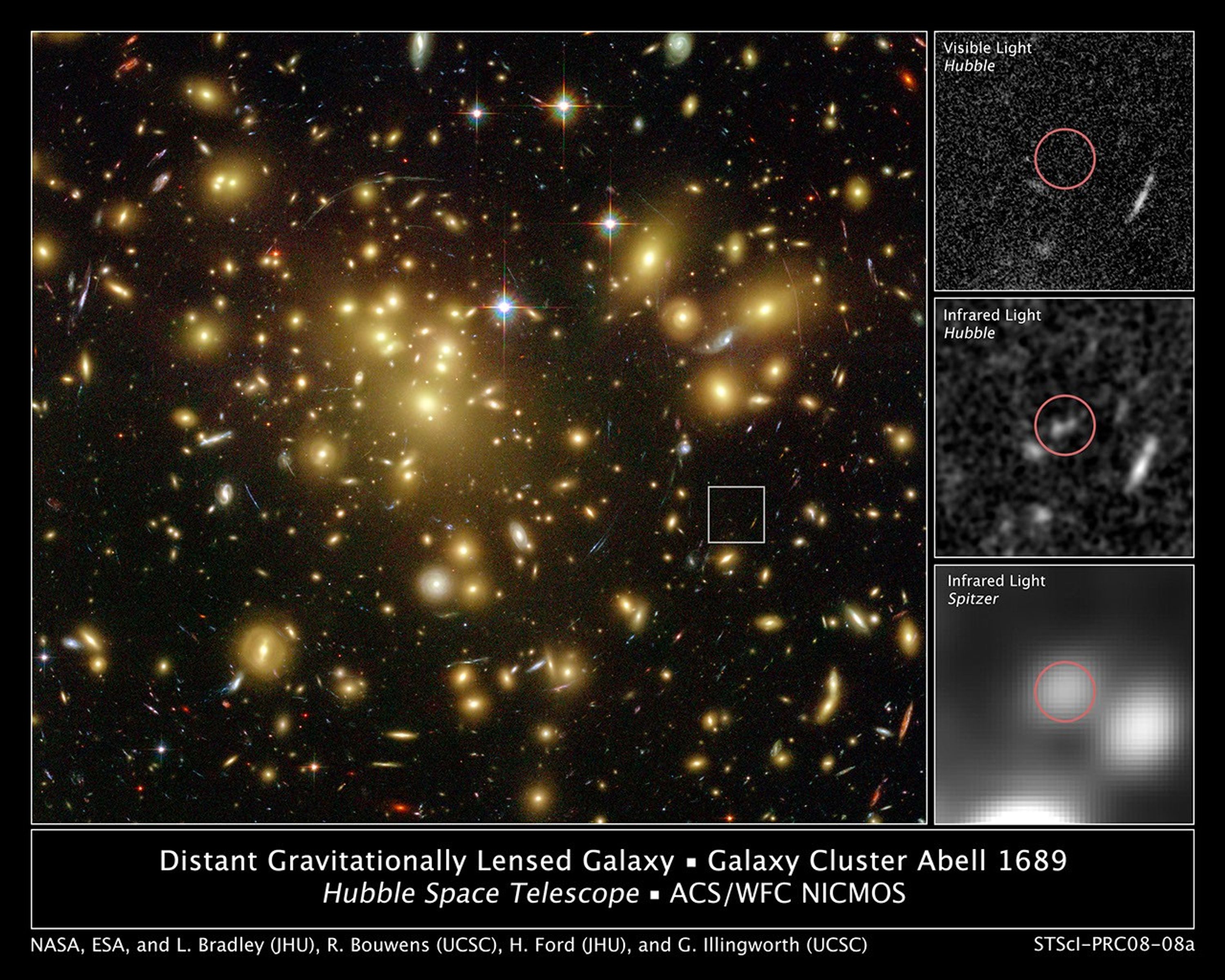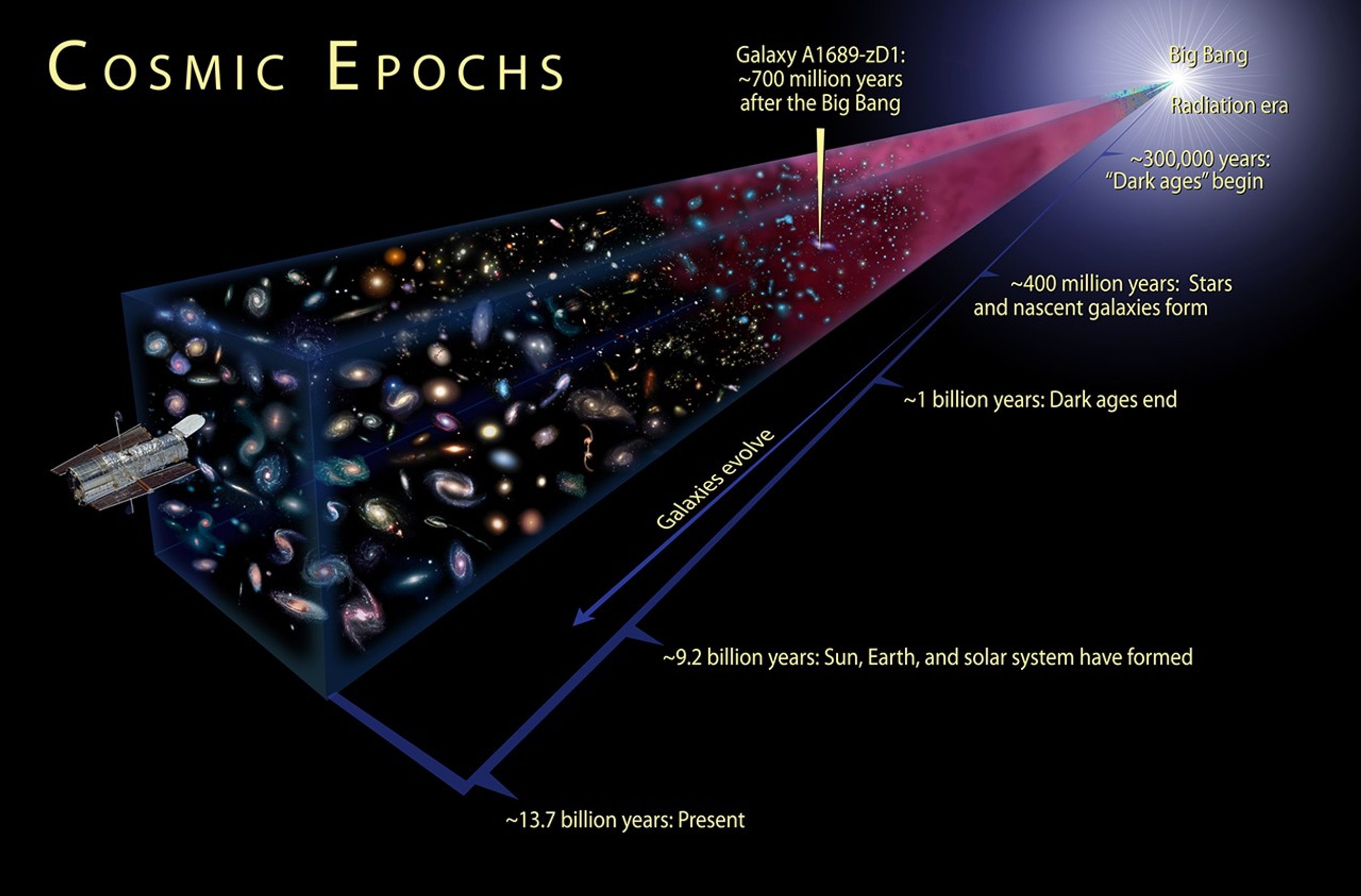1 min read
Astronomers Find One of the Youngest and Brightest Galaxies in the Early Universe

A massive cluster of yellowish galaxies is seemingly caught in a spider web of eerily distorted background galaxies in the left-hand image, taken with the Advanced Camera for Surveys (ACS) aboard NASA's Hubble Space Telescope.
The gravity of the cluster's trillion stars acts as a cosmic "zoom lens," bending and magnifying the light of the galaxies located far behind it, a technique called gravitational lensing. The faraway galaxies appear in the Hubble image as arc-shaped objects around the cluster, named Abell 1689. The increased magnification allows astronomers to study remote galaxies in greater detail.
One galaxy is so far away, however, it does not show up in the visible-light image taken with ACS [top, right], because its light is stretched to invisible infrared wavelengths by the universe's expansion.
Astronomers used Hubble's Near Infrared Camera and Multi-Object Spectrometer (NICMOS) and NASA's Spitzer Space Telescope with its Infrared Array Camera (IRAC) – with help from the gravitational lensing cluster – to see the faraway galaxy.
The distant galaxy, dubbed A1689-zD1, appears as a grayish-white smudge in the close- up view taken with Hubble's NICMOS [center, right], and as a whitish blob in the Spitzer IRAC close-up view [bottom, right]. The galaxy is brimming with star birth. Hubble and Spitzer worked together to show that it is one of the youngest galaxies ever discovered. Astronomers estimate that the galaxy is 12.8 billion light-years away. Abell 1689 is 2.2 billion light-years away.
A1689-zD1 was born during the middle of the "dark ages," a period in the early universe when the first stars and galaxies were just beginning to burst to life. The dark ages lasted from about 400,000 to roughly a billion years after the Big Bang. Astronomers think that A1689-zD1 was one of the galaxies that helped end the dark ages.
The ACS images were taken in 2002, the NICMOS images in 2005 and 2007, and the Spitzer IRAC images in 2006.
About the Object
- R.A. PositionR.A. PositionRight ascension – analogous to longitude – is one component of an object's position.13h 11m 34.19s
- Dec. PositionDec. PositionDeclination – analogous to latitude – is one component of an object's position.-1° 21' 56.0"
- ConstellationConstellationOne of 88 recognized regions of the celestial sphere in which the object appears.Virgo
- DistanceDistanceThe physical distance from Earth to the astronomical object. Distances within our solar system are usually measured in Astronomical Units (AU). Distances between stars are usually measured in light-years. Interstellar distances can also be measured in parsecs.The distance to the lensing cluster (left) is 2.2 billion light-years (675 megaparsecs). The distance to the lensed galaxy (right) is about 12.8 billion light-years.
About the Data
- Data DescriptionData DescriptionProposal: A description of the observations, their scientific justification, and the links to the data available in the science archive.
Science Team: The astronomers who planned the observations and analyzed the data. "PI" refers to the Principal Investigator.The ACS data used in this study was from HST Proposal: 9289. The NICMOS data used in this study was from HST Proposal: 10150 and 10996. The archival data used in this study was from Spitzer proposal 20439. Science Team: L. Bradley (The Johns Hopkins University), R. Bouwens (University of California - Santa Cruz), H. Ford (The Johns Hopkins University), G. Illingworth (University of California - Santa Cruz), M. Jee (University of California - Davis), N. Benítez (Instituto de Matemáticas y Física Fundamental), T. Broadhurst (Tel Aviv University), M. Franx (Leiden Observatory), B. Frye (Dublin City University), L. Infante (Pontificia Universidad Católica), V. Motta (Universidad de Valparaíso), P. Rosati (European Southern Observatory), R. White (Space Telescope Science Institute), and W. Zheng (The Johns Hopkins University). - InstrumentInstrumentThe science instrument used to produce the data.HST>ACS/WFC, HST>NICMOS/NIC3, and SST>IRAC
- Exposure DatesExposure DatesThe date(s) that the telescope made its observations and the total exposure time.June 12-21, 2006, Exposure Time: 13.2 hours (ACS), March 18-May 28, 2005 and June 14, 2007, Exposure Time: 14.1 hours (NICMOS), Feb 11-12, 2006, Exposure Time: 22.2 hours (IRAC)
- FiltersFiltersThe camera filters that were used in the science observations.June 12-21, 2006, Exposure Time: 13.2 hours (ACS), March 18-May 28, 2005 and June 14, 2007, Exposure Time: 14.1 hours (NICMOS), Feb 11-12, 2006, Exposure Time: 22.2 hours (IRAC)
- Object NameObject NameA name or catalog number that astronomers use to identify an astronomical object.Abell 1689 (left), Distant Gravitationally lensed galaxy (right)
- Object DescriptionObject DescriptionThe type of astronomical object.Galaxy Cluster, Distant galaxy, Gravitational lensed galaxy
- Release DateFebruary 12, 2008
- Science ReleaseAstronomers Uncover One of the Youngest and Brightest Galaxies in the Early Universe
- Credit

The color image of Abell 1689 is a composite of separate exposures made by the ACS instrument on the Hubble Space Telescope. Three filters were used to sample broad wavelength ranges. The color results from assigning different hues (colors) to each monochromatic image. In this case, the assigned colors are: Blue: F475W (g) Green: F625W (r) Red: F850LP (z)

Related Images & Videos

A Young Galaxy Brimming with Star Birth
This is an artist's impression of an embryonic galaxy brimming with star birth in the early universe, less than a billion years after the Big Bang. The galaxy is still forming and looks nothing like the majestic spiral and elliptical galaxies that are neighbors of our Milky Way...
Share
Details
Claire Andreoli
NASA’s Goddard Space Flight Center
Greenbelt, Maryland
claire.andreoli@nasa.gov

































